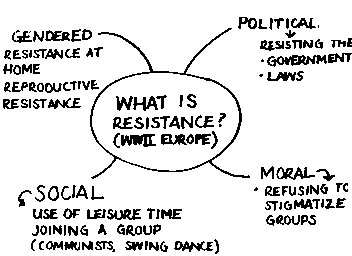Main navigation
Brainstorming is a valuable way to begin thinking about an assignment. By throwing ideas down on a page you can see what you remember about a given subject, spot weak points in what you know, and draw connections between different ideas without having to be organized in your thinking. You can make as much mess as you like -- the idea is simply to give yourself time and space to think about your project before you begin to write your first draft.
Here are some initial suggestions as you begin to brainstorm:
- Start early. Developing ideas can sometimes be a time-consuming process. Leave yourself plenty of time to brainstorm, organize, outline, write drafts, reorganize and proofread your essay.
- Find a place to write that inspires your creative process. If your room is too distracting, go to the library. If you need noise, turn on the radio. Figure out what works for you and go with it.
- Use informal writing to get some initial ideas down on paper. This is helpful especially if formal writing seems intimidating. Freewrite, scribble, jot ideas in a journal or make lists and charts (see below). You might surprise yourself and realize you have more ideas than you thought.
Making lists
Some projects lend themselves to lists very easily. If your assignment asks your to compare two points of view, or work out what a person believed about a particular issue, for example, lists can help.
For example, if your instructor asked you to decide whether or not we should continue to fund the space program, you could make lists to help decide what you will argue. (These are just random examples. Do not take them too seriously or use them for your own papers.)
For:
- Medical breakthroughs
- Defense
- Global Unity
- Contact with other lifeforms
- Understanding the evolution of the Earth
- Communications technology
Against:
- Diversion of funds from education, poverty relief, housing
- The Cold War is over
- Creates new competition between nations
- Negative perceptions of the USA from abroad
- Environmental impact here and now
- The technology breakdowns (e.g. faulty satellites)
From here you can decide which position you want to argue. You have a clear sense of what your opponents believe, and you have the beginnings of an outline for your paper.
Drawing charts
Diagrams and charts are great ways to not only write down what you know, but to visually make connections between important points. For example, if your instructor asked you to define 'Resistance' in World War II Europe, you might draw a diagram that looks something like the one below.

Once you have your basic ideas (like the ones above) you could use different colors to make connections between different areas. For example, reproductive resistance could be linked to political resistance, since it might involve breaking or defying laws. Moral resistance might be linked to social resistance, since you might join a group in order to show that you aren't stigmatizing them. This is a great way to get some preliminary thoughts together before you make an outline.
Gathering your thoughts
As you turn toward writing your paper, set down your notes and try to focus on your main idea, question or goal of your paper. Once you get a clear idea of this, write it down for later reference. You can use this to keep yourself on track during the writing process. If an idea, sentence, or paragraph does not directly relate to this idea, decide whether to scrap this section or to retrace your steps and revise your main idea, question or goal.
- Ask yourself “So what?” about the ramifications of your thesis or main idea. This can help you create a stronger thesis. What are the implications? What does it mean? A carefully-constructed thesis answers these questions for your reader.
- Ignore spelling, grammar, and punctuation until a later draft. Let your ideas flow and deal with technicalities later. This also means that you should schedule your writing so that you have time to do several drafts of revisions later.
- Start writing where you feel most confident. Writing an introduction can be intimidating, but there is no rule that says that you have to write it first. In fact, it may make sense for you to write it after you have completed most of your paper. Some people write an introduction to start them rolling and then delete it once they have written their body – only to rewrite it from scratch once they have the main argument written.
- Once you have a draft, don’t be afraid to change things around. Examine what you have and see if it works. Is it organized well? Does it make sense? Cut and paste are wonderful inventions!